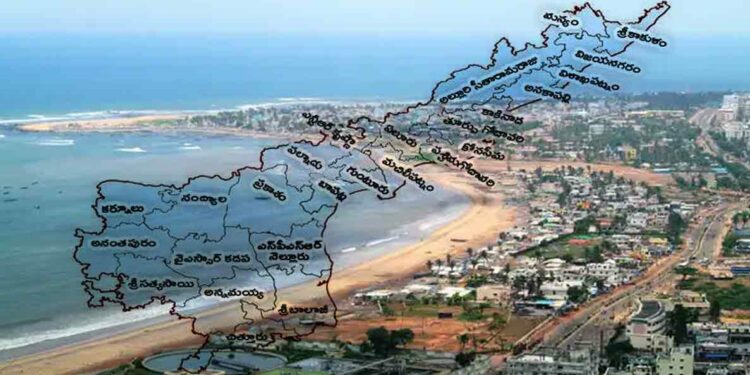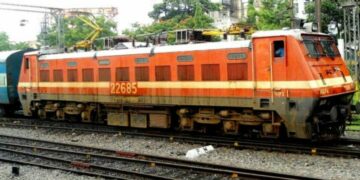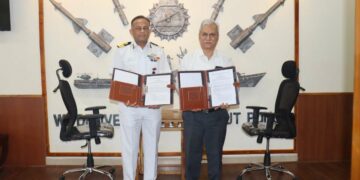Recently, the Government of Andhra Pradesh has taken up district reorganization and said that the current 13 districts will be reconstituted into 26 districts. District reorganization is not something uncommon in Andhra Pradesh. Ever since the districts were first constituted in Andhra Pradesh, they had undergone district reorganization several times in the last 200 years. The British East India Company (EIC), which entered India in the 17th century for trading purposes, soon started acquiring territories in the country. They had no idea or experience in revenue administration. Initially, they followed the same system of revenue collection which was then prevalent in their acquired territories and entrusted the authority to collect revenue to the same officials who were working under Fouzdars or Zamindars. This system continued till 1769.
When the British Company wanted to take over the revenue administration in the Northern Circars, they converted their principal commercial settlements into administrative centres and the Chiefs and Councils at Chicacole, Visakhapatnam (Vizagapatam), Ganjam, and Masulipatnam were given the charge of revenue administration for the Northern Circars. The Ichapur division of Chicacole Circar was placed under the Chief and Council of Ganjam. The Chicacole division and Casimcota division of Chicacole Circar was placed under the Chief and Council of Visakhapatnam and the Circars of Rajahmundry, Ellore and Kondapalli or Mustafanagar was placed under the Chief and Council of Machilipatnam. The fifth circar of Mustafabad or Kondaveedu or Guntur Circar did not go under British control till 1788.
Over a period of time, the EIC made different changes in their revenue administration. In 1786, a Board of Revenue was formed at Madras, on the plan of the Committee of Revenue that was in existence in Bengal. In 1787, European collectors and assistants were appointed, only for Haveli lands in the Northern Circars, who were made to report to the Board of Revenue. But in 1792, they were made to report to the Chiefs and Councils making them their subordinates. Dissatisfied with this system of governance, the court of directors of the East India Company advised the Government in Madras to adopt its presidency, the Ryotwari system of assessment, and the revenue administration that was developed during the Bengal presidency. Accordingly, the Madras Government abolished the Chiefs and Councils in the Northern Circars in 1794.
The Circars were divided into different divisions and European collectors were appointed for each division. They were independent and made to report to the Board of Revenue. In 1802, the circars were divided into districts and a collector was appointed for each district. For instance, the Chicacole Circar was divided into four divisions and had a collector for each division. The first division comprised of Ichapur division, The second division comprised Vizagapatam and Casimcota haveli lands. The third division comprised Vizianagaram Estate and the restored zamindaries. Lastly, the fourth division comprised the Chicacole, Tekkali haveli lands and the Kimedi Zamindari. Messrs Walter Balfour, John Snow, Nathaniel Webb, and Michel Keeting were the collectors for the said four divisions. In 1802 these four divisions were grouped to form two different districts namely Ganjam and Visakhapatnam (Vizagapatam) and district collectors were appointed. The office of the District Collector was thus established in 1802.
Formation of Districts
The present (in March 2021) 13 districts can be divided into three groups based on the way they were brought under the East India Company administration.
1. Northern Circars
These Circars were extended from Malud near Chilka Lake in the north to the Gundlakamma River in the south. Northern Circars were the first to come under British control in 1765 through a Farman issued by the Mughal Emperor and later ratified by the Nizam of Hyderabad in 1768. But Guntur came under the company only in 1788. These northern circars consisted roughly the present Srikakulam, Vizianagaram, Visakhapatnam, East Godavari, West Godavari, Krishna and Guntur districts.
2. Ceded Districts
The territory ceded to the British by the Nizam of Deccan in 1800 was formed into different districts and were called ceded districts. This territory was situated south of the Tungabhadra River. This ceded territory consisted of roughly the present Kadapa, Kurnool and Ananthapur districts.
3. Carnatic Districts
The East India Company termed the area south of Gundlakamma river, as Carnatic. The territory that was taken over by the British through a settlement made with Nawab of Carnatic consisted roughly the present Praksham, Nellore and Chittoor districts.
Northern Circars
The five northern circars that came into the hands of the EIC from the Mughals were Chicacole, Rajahmundry, Ellore, Mustafanagar or Kondpalli circar and Murtizanagar or Kondavidu or Guntoor Circar. In 1802, these circars were divided into five districts namely Ganjam, Visakhapatnam, Rajahmundry, Masulipatnam and Guntur. The Ichapur division of Chicacole Circar became Ganjam District. The Chicacole and Casimcota divisions of Chicacole Circar became Visakhapatnam District. The Circars of Rajahmundry, Ellore, Kondpalli or Mustafanagar and Kondaveedu or Mustafabad were made into three districts namely, Rajahmundry, Machilipatnam and Guntur.
The Ganjam district was formed in 1802 with Ganjam as its headquarters. The Chicacole which was in the Visakhapatnam District was incorporated into the Ganjam District in 1802. The first district collector of Ganjam thus formed was Peter Cherry. In 1815, the district headquarters was shifted to Berhampur. Again it was shifted to Chattrapur in 1902. When the Orissa state was formed in 1936 the Ganjam District was given to Orissa. But the Chicacole division was merged with Visakhapatnam District. The Visakhapatnam District was formed in 1802 with Visakhapatnam as its headquarters. Initially, there was a collector for each of the divisions in the district. In 1803 a District Collector was appointed for the district. Mr L.G.K Murray was the first collector. Chicacole was a part of the Visakhapatnam District. When the districts were initially formed in 1802, this district was the largest in the Madras Government. In 1950, the Visakhapatnam District was bifurcated into Srikakulam with its headquarters at Srikakulam.
In 1969 some villages of the district were separated to form a new Gajapatinagaram taluk which was included in Visakhapatnam District. Again in 1979, a new district of Vizianagaram with Vizianagaram as its headquarters was formed taking some parts of Srikakulam and Visakhapatnam districts. Thus, the three districts of Srikakulam in 1950, Vizianagaram in 1979 and Visakhapatnam in 1802 were formed. The three districts of Rajahmundry, Masulipatnam and Guntur were formed in 1802. In 1859-60, these three districts were made into two districts namely the Godavari and Krishna, named after the great rivers, with the Guntur District getting merged into Krishna with Masulipatam as district headquarters.
Kakinada (Coconada) was the district headquarters for the Godavari District. But again in 1904, the Krishna district was bifurcated into Krishna and Guntur with Masulipatnam as the district headquarters of Krishna and Guntur as the district headquarters of Guntur. The Ongole taluk, which was initially in the Nellore District, was added to the Guntur District in 1904. Thus the Krishna and Guntur districts were formed in 1905. In 1925 the old Godavari district was bifurcated into East Godavari with Kakinada (Cocanada) as its headquarters and West Godavari with Eluru as its headquarters. Thus, the four districts of East and West Godavari districts were formed in 1925 and Krishna and Guntur in 1905 were formed.
Ceded Districts
In 1800 the Nawab of Deccan ceded to the British all the territories acquired by him after the second and the third Mysore wars in 1792 and 1799. These territories lie to the south of the Tungabhadra River. Their entire territory was made into a Commissionerate and Col Thomas Monro took over that territory as Principal Collector with four deputies. He was stationed at Ananthapur making it his headquarters and his four deputies were stationed at Harpanhalli, Adoni, Cuddapah and Kambham. This form of Commissionerate continued up to 1808 when this whole ceded territory was split into two districts namely Bellary district with Bellary as its headquarters and Cuddapah district with Sidhot or Siddhavattam as its headquarters. Later the district headquarters of Cuddapah was shifted to Cuddapah in 1812. The Ananthapur district was formed in 1882 by splitting the Bellary district into two districts Bellary and Ananthapur. Anantapur was made the district headquarters for Ananthapur. The formation of the Kurnool district was different from the formation of other districts of the present Andhra Pradesh. The four taluks of Ramallakota, Nandikottukur, Nandyal, and Sirvel were ceded by Nawab of Deccan in 1800. But the local Nawab of Kurnool still held them as his Jageer. In 1839 after the last Nawab of Kurnool was killed by his own men, his territory went into the hands of the British. From 1839 to 1858 this territory was administered by the British Commissioner and Agent. Kurnool district was made into a Collectorate in 1858 by adding three taluks of Cuddapah district, namely Koilkuntla, Cumbum and Markapur and also Pattikonda taluk of Bellary. Thus the districts of Cuddapah in 1812, Anantapur in 1882 and Kurnool in 1858 were formed. After Independence in 1947 when linguistic states were formed in 1956, the Bellari district was included in Karnataka State.
Carnatic Districts
The Carnatic districts of Nellore, North Arcot, South Arcot, Madura, Trichinopoly and Tinnevelly went into British control through a settlement made with the then Nawab of Carnatic in 1801. Nellore District was formed in 1801. Mr Travers was the first collector for the district. The Jaghir of Udayagiri was sequestered in 1838 and included in the district. North Arcot district was formed in 1801 with Chittoor as the district headquarters. Later in 1911, the Chittoor district was separated from North Arcot with Chittoor as headquarters and Vellore as headquarters for North Arcot District. When Andhra got separated from Madras in 1953, the other districts ceded by Nawab of Carnatic namely, North Arcot, South Arcot, Madhura, Trichinopoly and Tinnevelly were retained in Madras state while Nellore and Chittoor districts were given to Andhra. Thus the districts of Nellore in 1801 and Chittoor in 1911 were formed. Prakasam District was formed as Ongole district in 1970 carving out small portions of the original Ceded and Carnatic Districts.
The divisions included are the Ongole division from Guntur district, which was originally in Nellore district before 1905, Kandukur revenue division from Nellore district and Markapur division from Kurnool district. Ongole district was named Prakasam district in 1972 in memory of Tanguturi Prakasam who was for some time the Chief Minister of Madras composite state and the first Chief Minister of Andhra State after it was separated from Madras. Prakasam was the first district to be named after a great personality. This trend of naming the districts after individuals of repute has picked up fast. The Kadapa district was named as YSR district after the late Chief Minister of united Andhra Pradesh YS Rajahsekhar Reddy. Since the name was too long and also since the former Chief Minister is most popular as YSR, the then government decided to rename Kadapa as YSR District in 2010. Now with the district reorganization, history will be created in the administration of Andhra Pradesh.
Written by Vijjeswarapu Edward Paul, a city-based heritage conversationist. A retired Shipping Manager by profession, the septuagenarian, belying his age, has been collecting data on Vizag from British Library, London, Tamil Nadu Govt. archives, Christian Theological College archives at Bangalore and Hyderabad, and other public libraries.
Comment below your opinions on the decision of district reorganization in Andhra Pradesh.










Discussion about this post